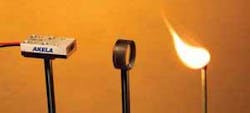LASER IGNITION: COD prediction optimizes laser-assisted initiation sources
Technology once relegated to secret defense laboratories is finally seeing the light. High-power laser-diode technology has matured to the extent that laser-assisted initiation (which encompasses both ignition and detonation) of a variety of substances is finding application not only in the defense industry, but also for controlled demolition in the construction industry, for rocket-motor ignition useful in the launch of satellites and space-exploration vehicles, and even for ignition in future combustion engines.
The primary motivation for using optical initiators—lasers—to replace electrically based igniters, actuators, or detonators is the fact that lasers have no bridgewire or electrical pathway into the explosive or pyrotechnic material, making them immune to common electrical threats such as electrostatic discharge or other transient electrical currents that could cause an explosion.
“The inherent safety of laser-assisted initiation has tremendous potential for both defense and civil applications,” says Mikhail A. Maiorov, CEO of Akela Laser (Monmouth Junction, NJ). At the SPIE Optics + Photonics 2009 conference (Aug. 2 to 6; San Diego, CA), Maiorov presented Akela’s techniques for simplifying the prequalification of laser diodes for initiation applications. The analysis of gallium arsenide (GaAs)- and indium phosphide (InP)-based high-power laser diodes shows that the power is sufficient for using the devices as initiators, thus enabling a broad range of diode wavelengths to be better matched to the absorption characteristics of the particular explosive or pyrotechnic material being used.1
Laser thermal initiation
Laser-assisted ignition is particularly attractive for explosives that can be initiated thermally. For example, the pyrotechnic material titanium potassium perchlorate can be ignited by short, low-power pulses from gallium aluminum arsenide laser diodes operating at wavelengths near 1 µm. The minimum power and fluence needed to ignite a material depends on the material’s heat capacity, density, thermal conductivity, auto-ignition temperature, and spectrally dependent absorptivity. Insensitive materials such as pentaerythritol tetranitrate can only be detonated with high-power lasers that deliver relatively large quantities of energy. The sensitivity can be increased by doping the material with strong IR absorbers or selecting the laser wavelength that matches the material’s absorption spectrum. However, laser power that can be achieved from diodes operated in single-pulse mode remains the main parameter for successful initiation.
Characterizing the light source
One of the obstacles to the widespread use of laser-diode-based initiators is the technical difficulty in prequalifying the devices for single-pulse operation at the maximum achievable power. The power limit of the GaAs-based diode lasers is defined by the temperature rise of the laser front facet followed by its catastrophic optical damage (COD). To address the issue, Akela developed a simple nondestructive method for estimating the COD level of the source that can certify the reliability of a particular diode going into a firing set rather than relying on destructive testing of similar devices.
To avoid the complexity of using various spectroscopic or thermoreflectance methods for monitoring front-facet temperature, Akela uses a technique based on monitoring the dynamic behavior of the laser-diode far field during pulsed operation. Despite high COD prediction accuracy (within 5%), the experimental setup is quite simple and can be reduced to only two high-speed photodetectors: one measuring the intensity at the center of the laser far field and another measuring the intensity at its shoulder. The COD prediction is made by analyzing the dynamics of the far-field broadening during the pulse, or measuring the ratio of the center-to-shoulder intensities.
It was also shown that the single-pulse operation of InP-based lasers covering the 1.2 to 2.0 µm range is not limited by the COD; these devices can be simply tested up to or above the required power level to guarantee failure-free use in laser initiators.
Maiorov hopes that the simplicity of the method will facilitate quick adoption of the technique in the industry. “The Optical Technologies for Arming, Safing, Fuzing, and Firing conference at SPIE Optics + Photonics is quite unique,” he says. “It is the world’s only nonclassified conference of its kind, bringing together members of the explosives community with laser and optics experts from industry and academia. Starting with this conference, we want to set an example of efficient interaction of scientists and engineers to ensure rapid development of defense technologies and timely adoption of existing solutions in numerous civil applications.”
REFERENCE
- M. Maiorov et al., SPIE Optics + Photonics 2009, Optical Engineering + Applications conference 7434, paper 7434-03, San Diego, CA (Aug. 5, 2009).

Gail Overton | Senior Editor (2004-2020)
Gail has more than 30 years of engineering, marketing, product management, and editorial experience in the photonics and optical communications industry. Before joining the staff at Laser Focus World in 2004, she held many product management and product marketing roles in the fiber-optics industry, most notably at Hughes (El Segundo, CA), GTE Labs (Waltham, MA), Corning (Corning, NY), Photon Kinetics (Beaverton, OR), and Newport Corporation (Irvine, CA). During her marketing career, Gail published articles in WDM Solutions and Sensors magazine and traveled internationally to conduct product and sales training. Gail received her BS degree in physics, with an emphasis in optics, from San Diego State University in San Diego, CA in May 1986.
